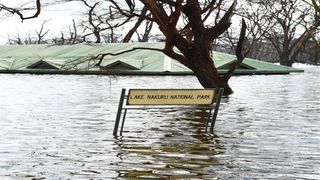
Structures at Lake Nakuru National park main gate are submerged by rising waters on October 1, 2020.
| Cheboite Kigen | Nation Media GroupWhat you need to know:
Death, disease and a Sh2 billion loss. This is the anguish caused by the rising Rift Valley lakes. It is going to take years to recover from this, experts now warn.
Death, disease and a Sh2 billion loss. This is the anguish caused by the rising Rift Valley lakes. It is going to take years to recover from this, experts now warn.
To start the recovery journey, it has now become urgent to establish the cause of the phenomenon. A crisis, is what a team of experts has termed the situation in Rift Valley and the Lake Victoria Basin, where lake waters have risen to levels not seen in decades.
While the whole destruction is yet to be fully quantified, already a preliminary report shows that the loss amounts to Sh2.4 billion, which is just the tip of the iceberg.
“From the preliminary assessment, the rising water levels have caused a crisis that calls for urgent, concerted effort,” said Environment Principal Secretary Chris Kiptoo last week as he released the report.
Some 75,987 households have been affected by the flooded lakes and now the government needs some Sh2.9 billion for a short-term intervention. Hundreds of thousands of those affected urgently need food, shelter, emergency health services, clean drinking water, hygiene and sanitation facilities.
“The government needs to mobilise resources to address the issue. A comprehensive study should be conducted on the hydrology, geology, ecosystems and social economic factors at play in the region to clearly understand the causes of this phenomenon and its impacts,” he said.
When lakes Naivasha, Nakuru, Baringo, Bogoria, Turkana and Victoria kept rising without stopping, the government decided to establish a multi-agency technical committee to try and establish the cause and the levels of destruction. The team conducted a study between October 21 and November 1, 2020. Besides trying to explain the reasons behind the rising lakes, the team also collected information and data on the extent of the flooding and its impact.
From health, education, energy, water, agriculture, environment to infrastructure, the damage has been felt in all sectors.
Lake Baringo
Lake Baringo, which has more than doubled its radius, with 136km² of new land currently under water, has caused destruction of 24 learning institutions. Ten schools are totally submerged and 14 others are partially under water. In 12 submerged Baringo villages, all health centres went under water, curtailing access to medical services.
This is besides the water cutting off electricity, after power lines were disconnected in some areas. Without power, storage of drug and vaccines at the health centres was compromised, the report states.
A crocodile basks on the roof of a house submerged in Lake Baringo's waters at Loruk.
Just like other areas where roads have been cut off, the Marigat-Karandi road was submerged, affecting movement.
An aerial view of the rising water levels from Lake Baringo.
Tourism also took a hit after at least seven tourist facilities, including hotels, were submerged around Lake Baringo, states the report. These include Lake Baringo Club, Soi Safari Lodge, Roberts’s Camp, Papyrus hotel, Zakayos, Lake Bogoria airstrip, Tumbili cliff and Island camp.
Lake Bogoria
The story is no different at the Lake Bogoria basin. About 9km² of riparian land is submerged. This has reduced the flamingo population from as many as 1.5 million to less than 100,000. At least 200 (80 per cent) of the hot geysers of Lake Bogoria have also been submerged, dealing a blow to both local and international tourism.
Housing structures submerged in Lake Bogoria's waters.
Lake Nakuru
And due to the flooding, flamingos, waterbucks and the yellow fever acacia have lost their homes at the Lake Nakuru basin.
At least 33km² of the Nakuru National Park land is submerged. The Lake Nakuru Park management buildings have been submerged since 2013, the report states. Ninety per cent of the roads that existed before the flooding started in 2010 are under water.
Structures at Lake Nakuru National park main gate are submerged by rising waters on October 1, 2020.
The Lake Nakuru National park main gate on October 1, 2020.
The Kenya Wildlife Service (KWS) had to rehabilitate the park infrastructure at a cost of Sh50 million and also used Sh105 million to rebuild roads.
Lakes Elementaita and Naivasha - Stress, depression
At the neighbouring Lake Elementaita, flamingos, whose number went down, have lost their homes. Due to increased lake water, salinity has decreased and, therefore, microorganisms such as phytoplankton and zooplankton -- food for fish, have been lost. As a result of the habitat destruction, breeding sites for birds and fish have been destroyed as well. The lake’s ecology has changed, leading to biodiversity loss.
Around Lake Naivasha, stress and depression is on the rise. Six people died in Kihoto as a result of depression after their property and farms were destroyed by the water, says the report.
Thousands have been displaced by the water, with an estimated 500 households displaced by the rising water level of Lake Naivasha.
Roads worth Sh100 million have been destroyed as well as power transformers and beaches, several tourist hotels, flower farms, and 264.8 hectares of land submerged.
“Waterborne diseases and malaria have become prevalent in Naivasha due to over-flowing toilets and stagnant water,” says the report.
In Solai, 6,000 acres of pastoral and agriculture land was lost to the rising water, while a five-kilometre road was submerged and had to be rebuilt on higher ground.
Lake Turkana
The situation is the same around Lake Turkana where several people have died from 19 crocodile attacks. Almost 2,000 acres of irrigation schemes have been submerged by rising waters. Thousands of people have been displaced in Longich village and the Impressa beach, which are now under water.
Aerial view of submerged houses in expanding Lake Turkana water at Kalokol, Turkana County on December 9, 2020.
By October 23, last year, the Turkwel Gorge Dam level was only 1.8m shy of being full, risking a spill that could cause more destruction.
Already, more than 30,000 people have been displaced, 13 schools with 2,700 pupils are flooded and more than 6,000 acres of grazing land and 11 fish landing beaches have been destroyed by River Turkwel. The flooding has destroyed a 35-kilometre road, 16 boreholes and three health centres in the area.
Lake Victoria
Things are no different around the Lake Victoria basin, where water utilities were destroyed, exposing residents to future water shortages. Four water supply intakes in Homa Bay have been destroyed, causing a loss of Sh1.1 billion, in addition to the destruction of the Homawasco sewerage treatment plant worth more than Sh145 million.
Siaya County has also lost five water supply intakes worth more than Sh151 million. As such, thousands of people lack clean drinking water, which could cause increased waterborne diseases.
The lakes’ catchment degradation has caused loss of lives and property. For example, at the Sebit Centre, 13 people were swept away by flash floods and 103 households destroyed during a down pour in 2019.
What's causing all this?
The team of experts attributes the rising lakes to persistent rainfall over the catchment areas draining into the lakes from the October-November-December rainfall of 2010.
Increased discharge from springs and groundwater input due to saturated sub-surface and recharged groundwater have also been linked to the phenomenon.
Long-term lake sedimentation through rivers, reduced evapotranspiration over the prolonged rainfall periods and catchment degradation from human activities are also to blame.
Except for Lake Victoria, the other lakes are located in a confined basin on the floor of the Rift Valley, which does not allow open discharge.
Over the years from 2010, Kenya has witnessed episodes of heavy rainfall especially due to the Indian Ocean Dipole and El-Nino weather phenomena and this is also attributed to the rising lakes.
“The rise of lake water levels could be due to climatic approximate 50-year cycle as evidenced by historical records (1901, 1963),” states the report.
And increased built environment and poor land use have led to poor infiltration of rain water and caused increased runoff, consequently silting the lakes.




